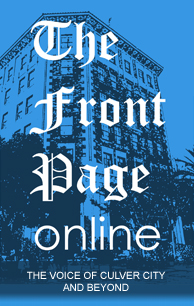[Editor’s Note: This is the third of three parts backgrounding Culver City’s long promised elevated light rail station, for which government funding was approved last week. See Part 1, “Cunningham the Optimist on How and Why Metro Board
Got the Vote Right,” Dec. 4, and Part 2, “Aerial Station Owes Its Life to ‘Right Time, Right Place’ — Cunningham,” Dec. 5.]
During his 22 years in Culver City, the soon-to-retire Director of Transportation has closely studied the complexities of traffic on the Westside, reputedly the crown jewel of Los Angeles.
If the Westside is the golden child, it has not been treated like one. It has been snubbed by one major faction of government.
With the nearly 9-mile Expo Light Rail line, from downtown Los Angeles to Washington and National in Culver City due in 2 1/2 years, an underappreciated drought will end.
“Historically,” said Mr. Cunningham, “the Westside has not been a recipient of transportation dollars. There have been no significant transportation improvements on the Westside in decades, basically since the freeways were built, late 1950s, early ‘60s.”
Q. For political or other reasons?
Mr. Cunningham: “For many years, the Westside was kind of insular, and that is why I say, it won’t hurt for those of us on the Westside to work together.
“Look at the cities. You have West Hollywood, Beverly Hills, Culver City, Santa Monica.”
Q. Are you hinting the Westside is elitist?
Mr. Cunningham: “Not my word.
“We tend to be parochial at times. Historically, the cities used to be very parochial about how they approached their issues and problems. The Westside Council of Governments is a relatively recently formed organization.
“Transportation was the genesis for the cities saying to each other, ‘We have a lot in common. We need to approach these issues in a different manner.’ L.A., the big 800-pound gorilla that sneaks around among us, is involved.
“All of this is leading to a different way of attacking the problems that, traditionally, we have not been successful in handling.”
Q. What is your opinion of the recent suggestion that, to speed up traffic to and from the Westside, Pico Boulevard and Olympic be converted into one-way streets?
Mr. Cunningham: “The latest proposal is to orient the signal lights so that Pico will get a heckuva lot of green going eastbound and Olympic will get a heckuva lot of green going westbound at peak periods.
“They will still operate as two-way streets but they will favor a directional traffic flow during morning and evening peaks.”
Q. That seems like an almost too simple solution. Is it?
Mr. Cunningham: “The idea has some merit. My concern, though, is what happens to the north-south traffic flow when you have what in essence could be two barriers now.
“We have a tough enough time with north-south traffic flow on the Westside. East-west works — we have a lot of that. We don’t have a lot of north-south. Anybody who has driven Sepulveda Boulevard when the 405 Freeway goes down knows what our challenges are there.
“I have a side concern. You are right that, on the surface, it seems simple.
“For Culver City, my focus is more north-south traffic oriented. You have seen Overland Avenue when it gets backed up beyond belief. It is an impact to all of us. I have a major public transit route on Sepulveda Boulevard that is going to have Rapid Bus soon. My running commentary is that Rapid Bus and Sepulveda Boulevard are kind of an oxymoron.
“When Sepulveda goes down, the busses are stuck just like everybody else. “
Q. For Culver City workers and residents, can they put faith in the projection that the elevated light rail station and the rest of the Expo Light Rail line will be operating by the year 2010?
Mr. Cunningham: “It’s a goal, and it was a good number originally. But as projects tend to happen, there might be a little slippage, not huge. We might be talking six or nine months later. In a big construction project, that is a very short period of time.”
Q. Can you exhale and say with reasonable certitude that the elevated light rail station will be built? Or, are other minefields lurking?
Mr. Cunningham: “Culver City can exhale as confidently as anybody could. There are a couple of minor regulatory hurdles. For example, Caltrans has to approve the expenditure of the Prop. 1B funds for this project. That probably is just a rubber stamp. If this is how Metro Board wants to use it, this is how it’s going to get used.
“It has been cleared environmentally. The Metro Board has now taken its formal vote.
“To be brutally honest, if you were to ask me the one penultimate thing I would like to get done in Culver City before I retire (on April 11), this was it. I can breathe. I can exhale.
“You know what? It took a lot of years, a lot of conversation, a lot of people. Somehow, we got it done.”
